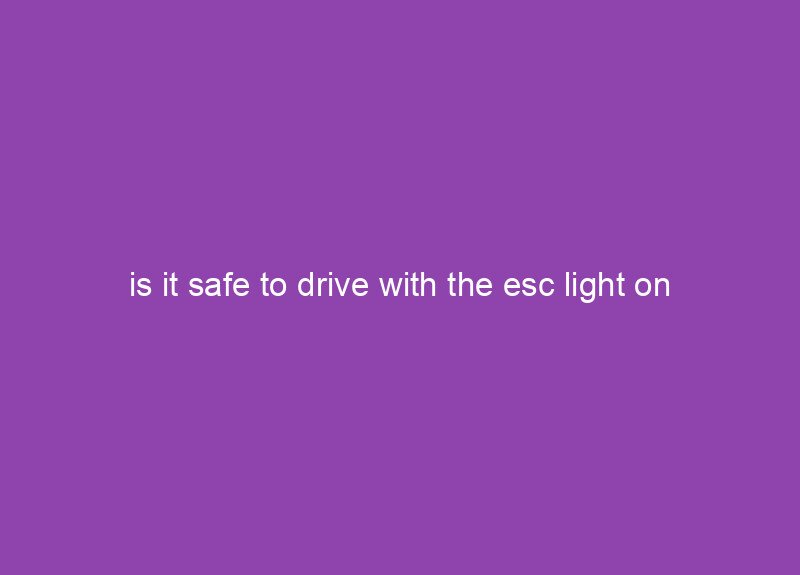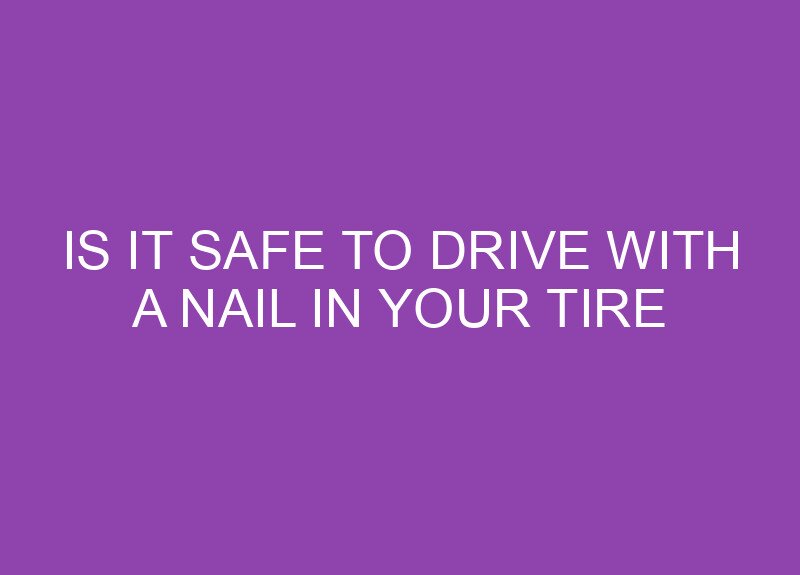Greetings, dear readers! Today, I’d like to delve into a topic that is quite perplexing for many of us motorists: driving with the ESC light on. Now, let me assure you, this is no trifling matter. The ESC light, also known as the Electronic Stability Control warning light, is an indicator that something is amiss with your vehicle’s traction control system, a crucial safety component. If left unattended, it can put you at an increased risk of losing control on the road, especially in hazardous conditions. Nonetheless, there are cases where driving with the ESC light on temporarily might not be as dire as it seems. In this blog post, I invite you on a journey to understand the intricacies of this warning light, its possible causes, and the appropriate actions you should take in such a situation. Sit tight; we have much to discover together!
Key Takeaways:
- Safe to drive with ESC light on: Driving with the ESC (Electronic Stability Control) light on is generally considered safe, but it is important to address the underlying issue causing the light to come on and have it repaired as soon as possible.
- ESC light indicates potential safety concerns: The ESC light typically illuminates when there is a fault or malfunction in the vehicle’s stability control system. While it doesn’t necessarily mean the vehicle is unsafe to drive, it implies that the system’s functions may not work properly in case of emergencies.
- Have the vehicle checked by a professional: When the ESC light comes on, it is recommended to have the vehicle inspected by a qualified mechanic. They can diagnose the issue and conduct any necessary repairs to ensure the vehicle’s stability control system functions as intended, providing maximum safety on the road.
Reasons for the ESC Light to Turn On
For those of us who rely on our vehicles for daily commuting or long road trips, it can be alarming when the ESC (Electronic Stability Control) light suddenly illuminates on our dashboard. This important safety feature is designed to assist in maintaining control of our vehicle during unstable driving conditions. However, when the ESC light turns on, it signals that a potential problem exists. In this chapter, I will explore some of the common reasons for the ESC light to turn on and help you understand the implications it may have on your driving safety.
Malfunctioning ABS Sensor
One of the possible reasons behind the ESC light illuminating is a malfunctioning ABS (Anti-lock Braking System) sensor. The ABS sensor plays a crucial role in providing data about wheel speed to the ESC system. When this sensor fails or becomes faulty, it disrupts the accurate transmission of information related to the rotational speed of the wheels. Consequently, the ESC light activates to notify you of a potential problem. It’s important to address this issue promptly, as a malfunctioning ABS sensor can compromise your vehicle’s stability and control, especially during sudden stops or adverse road conditions.
Faulty Wheel Speed Sensor
A faulty wheel speed sensor is another probable cause for the ESC light to turn on. The wheel speed sensor is responsible for monitoring the rotational speed of each wheel. It sends this information to the ESC system, allowing it to make precise adjustments to the vehicle’s braking and stability. However, when a wheel speed sensor is malfunctioning, it fails to provide accurate data, triggering the ESC light. Ignoring this warning and continuing to drive with a faulty wheel speed sensor can pose serious risks. It can compromise your ability to maintain control during quick maneuvers or emergency situations, jeopardizing your safety and that of others on the road.
Potential Risks of Driving with the ESC Light On
If you’ve ever noticed the ESC (Electronic Stability Control) light illuminating on your vehicle’s dashboard, it’s crucial not to overlook it. Driving with the ESC light on poses certain risks that can compromise your safety on the road. In this chapter, I will delve into the potential hazards associated with ignoring this warning light. Let’s explore the possible consequences and why it is important to address them promptly.
Decreased Stability and Traction Control
When the ESC light is on, it indicates that there is a fault in the electronic stability control system. This system plays a vital role in maintaining the stability and traction control of your vehicle. If you continue to drive without addressing the underlying issue, it can result in decreased stability and compromised traction on the road. This means that when you navigate corners or face sudden obstacles, your vehicle may not respond as expected, increasing the likelihood of an accident. It is important to note that the ESC light is a warning sign, indicating potential problems in these crucial areas of vehicle control.
Increased Risk of Skidding and Loss of Control
Another risk of driving with the ESC light on is an increased chance of skidding and loss of control. The ESC system actively monitors each wheel’s speed and applies braking force when needed to prevent the vehicle from skidding or going out of control. If this system is malfunctioning, it won’t be able to perform these corrective actions effectively. As a result, your vehicle could potentially skid during sudden maneuvers or lose control on slippery surfaces. This not only puts you in danger but also endangers others sharing the road with you. Ignoring the ESC light can significantly increase the likelihood of these dangerous situations.
Compromised Emergency Response
When driving, it is important to consider the safety aspect under various circumstances, including emergencies. If the ESC light remains on, it can compromise your vehicle’s emergency response system. In emergency braking situations or when swerving to avoid an obstacle, the ESC system assists in maintaining vehicle stability and control. However, with the ESC light continuously illuminated, the system will not operate optimally. This may result in compromised emergency response times and, therefore, increased risks when you need to rely on your vehicle’s swift reaction the most.
Overall, driving with the ESC light on poses several potential risks that can compromise your safety on the road. The decreased stability, compromised traction control, increased risk of skidding and loss of control, along with the compromised emergency response, highlight the importance of promptly addressing the ESC light warning. My goal is to ensure your safety and the safety of others on the road, so taking action to resolve any underlying issues should be your top priority.
Troubleshooting and Solutions for ESC Light Issues
Lastly, let’s discuss some troubleshooting steps and solutions for ESC light issues. If you encounter the ESC light turning on in your vehicle, it is essential to address the problem promptly to ensure your safety on the road. Ignoring the warning light can lead to compromised stability and traction control, risking potential accidents or loss of vehicle control.
Checking and Replacing ABS Sensors
One common cause for the ESC light to illuminate is a faulty ABS (anti-lock braking system) sensor. These sensors monitor the speed of each wheel and transmit data to the ESC system. If there is a malfunction or damage to any of these sensors, your ESC light may turn on. To check for issues with the ABS sensors, start by inspecting their connections and wiring for any signs of damage or corrosion.
If you notice any issues, such as loose or damaged connections, I recommend repairing or replacing the sensor and its associated wiring harness. You may also want to consider using a diagnostic tool to read the error codes stored in the vehicle’s computer system. These codes can provide valuable insights into which specific sensor or circuit is causing the ESC light to activate.
Remember, ensuring the proper functionality of ABS sensors is crucial for the ESC system to operate optimally. Faulty sensors should be dealt with promptly to restore the reliability of your vehicle’s stability control system.
Resolving Wheel Speed Sensor Problems
Another common culprit behind ESC light issues is a malfunctioning wheel speed sensor. These sensors detect the rotational speed of each wheel and communicate with the ESC system to adjust braking pressure and traction control. A malfunctioning wheel speed sensor can cause the ESC light to illuminate and affect the overall performance of your vehicle’s stability control.
If you suspect a problem with the wheel speed sensors, start by visually inspecting them for any physical damage or contamination. Ensure that the sensors are securely mounted and free from debris or excessive dirt. Cleaning the sensors gently with a soft brush and mild detergent can help remove any accumulated grime that might interfere with their proper functioning.
If cleaning does not resolve the issue, it is advisable to seek professional assistance for further diagnosis and potential replacement of the wheel speed sensor. Identifying and resolving problems related to these sensors is crucial to restore the ESC system’s effectiveness in maintaining your vehicle’s stability and traction control.
For more detailed information on ESC light issues and troubleshooting steps, I recommend checking out the informative blog post on Carfax.com titled “Traction Control or ESC Light On?”. This resource provides valuable insights and comprehensive guidance on identifying and resolving ESC light problems, ensuring your safety and peace of mind on the road.
Conclusion
Now, based on my knowledge and expertise as a professional driver, I strongly advise against driving with the ESC light on. Ignoring this warning light can potentially put you and others in danger on the road. The ESC system plays a crucial role in maintaining control and stability of your vehicle, especially during sudden maneuvers or on slippery surfaces. It is vital to promptly address any issues indicated by the ESC light to ensure your safety and prevent further damage to your vehicle. Remember, it’s always best to consult a qualified mechanic to diagnose the problem and make the necessary repairs before hitting the road again.
FAQ
Q: Is it safe to drive with the ESC light on?
A: No, it is not safe to drive with the ESC (Electronic Stability Control) light on. The ESC light indicates a problem with the system that helps maintain control over your vehicle. Driving with this light on can pose risks, as it may impact the stability and handling of your car.
Q: What does the ESC light indicate?
A: The ESC light typically indicates an issue with the Electronic Stability Control system in your vehicle. This system is designed to enhance the stability and control of your car, especially in situations where you may encounter loss of traction. When the ESC light illuminates, it signifies that the system has detected a problem that needs attention.
Q: What should I do if the ESC light comes on?
A: If the ESC light comes on while you are driving, it is advisable to take immediate action. Here are the steps you should follow:
1. Stay calm and focus on maintaining control of your vehicle.
2. Reduce your speed and avoid sudden maneuvers, such as hard braking or quick acceleration, as these can further compromise stability.
3. Safely pull over to the side of the road and turn off the engine.
4. Check your vehicle’s owner’s manual for specific instructions related to the ESC light.
5. If possible, contact a qualified mechanic or arrange for your vehicle to be inspected by a professional to diagnose and resolve the issue.
Remember, always prioritize safety when it comes to driving, and addressing any warning lights or system malfunctions promptly can help ensure the well-being of both yourself and others on the road.










